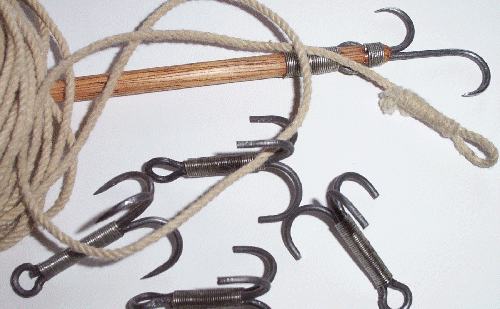 RandKL's
RandKL's
GI Joe Modeling Page
Grapnels and Grapples
Grapnels and Grapples
So what exactly is the difference between the two? Simple....a grapnel is designed for marine use to secure a boat in place. It's an anchor with individual "flukes" or spoons designed to dig into and grip the bottom. A grapple is a hook designed to grab everything else. A grappling hook or grappling iron is a grapple....a ship's anchor isn't. The easiest way to tell the difference is to look at the individual tines of the hook and see if they are flattened or not.
That explained, let me say this and then we will get to building something. We had planned to present both grapnels and grapples in this one but the grapnels text got deleted somehow in the move from the old site to here. We apparently saved an older copy of the file and deleted the newer. We hope you can forgive us, but it will be a while before we can redo it. Just too many other projects going on at the moment.
First item on the list is to gather the necessary materials of course. For this one, we'll need one wire coathanger, a good pair of pliers and something to cut the coathanger with, a spool of steel or zinced copper craft wire, a propane torch, and some metal formers (explained below).
Btw, this is a very easy project and you can turn out finished hooks on average about every ten minutes with some practice.
First step is to snip the coathanger hook off to open the hanger into one long piece of wire. Second step is to red-hot the entire thing to burn off any varnish coating and to anneal (soften) the steel.
Third step....and here we need the first former....we take a 6" piece of the annealed steel wire and bend it double around a suitable former of the right diameter. Approximately 1/4" diameter is fine. Kris and I prefer to use drill bits as formers because they come in lots of different sizes. Bend the 6" wire around the drill bit to form a large cotter pin like this.

Be sure to grip it down tight with your pliers to form a perfect eye around the drill bit!
Next, cut another length of your annealed wire and size it to the other two prongs. Don't worry about exactness....the prongs will be trimmed later.
Now lay your loose third wire (grey in this pic) on the other two and starting at the eye, begin wrapping the three tines tightly with your craft wire. Wrap approximately one inch of length and then hold the wire tight as you run a bead of cyanoacrylate down all three sides of the wrapped craft wire. Trim the ends of your craft wire and use your pliers to carefully bend the ends of the wire inward on the tines.

Now, carefully spread the three tines apart about a quarter inch and use your pliers to gently form each tine around another former. For this step, we use an old #3 Xacto knife handle (1/2" diameter). Carefully bend each tine until they're all bent evenly and angled outward from each other perfectly.
Once you're satisfied with your bends and angles, use your pliers to straighten the tine to finish the hook and then trim them all to the same length. All there is to it.

If you used steel coathanger wire or carbon welding rod, the hook will be dark grey. The zinc or steel wire can be heated to match the coloring of the hook tines if you want but the wire will age-darken naturally anyway. If you want a non-wrapped, ultra-modern hook type or if you want shiny, use nickle-silver wire instead of steel coathanger and silver solder the tines to form the hook. We don't do "modern" so we prefer the steel.
On the history side....the wrapped hook has been known since at least the Early Greek/pre-Roman era and still sees use in various militaries even today. Early examples were strictly sea combat weapons used against the rigging of an enemy ship and consisted of three separate tines wrapped around a center shaft. Separate tines allowed any one piece to be replaced without having to remake the entire hook.
Since this one was re-posted, we've had two folks ask about the gaff (the pole with the hooks) so....
Make your cotter pin from annealed coathanger wire just like before and shape your tines around a suitably-sized form such as a 1/2" diam drill bit or an Xacto knife handle etc. Instead of adding the third tine, we just crafted a pole and wired the two-pronged hook into the split pole end. The same idea could be used to form a trident or a self climbing ladder section etc.





